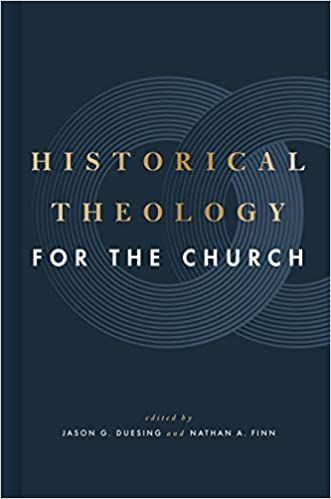A Book Review from Books At a Glance
by Justin Powell
Historical Theology for the Church is a wonderful bridge from academia to the Sunday School room. Duesing and Finn have gathered a group of scholars whose desire to serve churches with their academic prowess shines through this collection of essays. This gathering provides a concise, and yet robust, exploration through the eras of church history.
Both Duesing and Finn are well suited to edit such a volume as they have long histories leading scholars in training the next generation of pastors and church leaders. Dr. Jason Duesing is the academic provost and Professor of Historical Theology at Midwestern Baptist Theological Seminary in Kansas City, MO. Dr. Nathan Finn is Provost and Dean of Faculty at North Greenville University in Tigerville and Greer, SC.
Historical Theology For the Church divides church history into four main eras, and each chapter explores the main controversies of that era. With this structure, the reader is able to foresee patterns in history from the start. For example, the Church has wrestled with the relationship between Holy Scripture and Tradition since her beginnings, and continued into the Modern Era, though in very different ways. Likewise, Christians debated the role of the Church within the nations. And, the Church appears to be heeding Paul’s command to “work out [her] faith with fear and trembling” as they moved from one era to another in regards to soteriological controversies.
Historical theology’s general benefit is demonstrating the development of Christian faith which allows modern readers to understand their faith “did not begin with their grandmothers.” To that end, the authors reiterate for their primarily Protestant audience the necessity of studying Christian doctrine as it developed in history. By looking to the past, Christians can see from where they have come and understand the road ahead. Duesing introduces Historical Theology For the Church as in the tradition of “the Lord’s remembrancers”—a fitting description for this fitting tribute.
The overall structure is extremely helpful in terms of building this introductory text. The topics are wide enough to include the myriad of characters that informed Christianity’s development, but what truly helps the reader are the Case Studies that follow the main text. Akin to psychological study methods, the chapters introduce the main concepts and characters of history while the case study elucidates the main point. This pattern of alternating wide and deep allows the authors to pack in much more information than a volume of this size should be able to offer. It also gives the reader a myriad of departure points for further study.
Unit One classifies the Patristic Era as AD 100-500 and rightly focuses on the questions surrounding the nature of Christ, the Trinity, and Scripture. Unit Two moves to the Medieval Era, AD 500-1500, examining Christendom in light of its ecclesiology, soteriology, and scholasticism. Unit Three surveys the Reformation Era, AD 1500-1700. These three units hold chapters on the major issues of theology in their times, and it is both fitting and telling that each of them repeats chapters for Scripture and Salvation, as well as the Medieval and Reformation Eras having a chapter on the Church. This structure reinforces the truth Christianity has discussed many of the same questions in her 2000 years, though answers have varied during the centuries.
A definite shift occurs in Unit Four: Theology in the Modern Era, AD 1700-2000, in which Nathan Finn examines the role of authority in scripture interpretation, especially in light of the effects of the Reformation, Enlightenment, and modern science. This shift continues in “Creation and Humanity” by John Mark Yeats in which the modern human seeks an existence without the need for God (or any other god). The unit concludes with four more chapters that extend the topics of previous units into the modern era, revealing the current modern debates of the Church as something both very new and very ancient.
Historical Theology is written to be accessible to the student and layman alike. The chapters are relatively short, however, they include specific case studies and bibliographies for further research. These features make it worthwhile for the student. Additionally, the authors include summary statements that directly teach the church giving the lay congregant the “so what” for further discussion. Typically, a book that attempts to balance the academic world and the small group study tends to lack on one side. In this case, the authors, perhaps, lean a bit far from the academic side, however since Historical Theology For the Church is “for the church,” one expects such an imbalance. Whether the reader finds this as a strength or weakness of the book is determined by what the reader needs.
For the student who is taking their first step into church history, the read will give a hard push into a soft landing. For the small group, they may find the material a bit much, but the summary statements, as well as the provided follow-up questions, will certainly spur discussion.
Justin Powell
